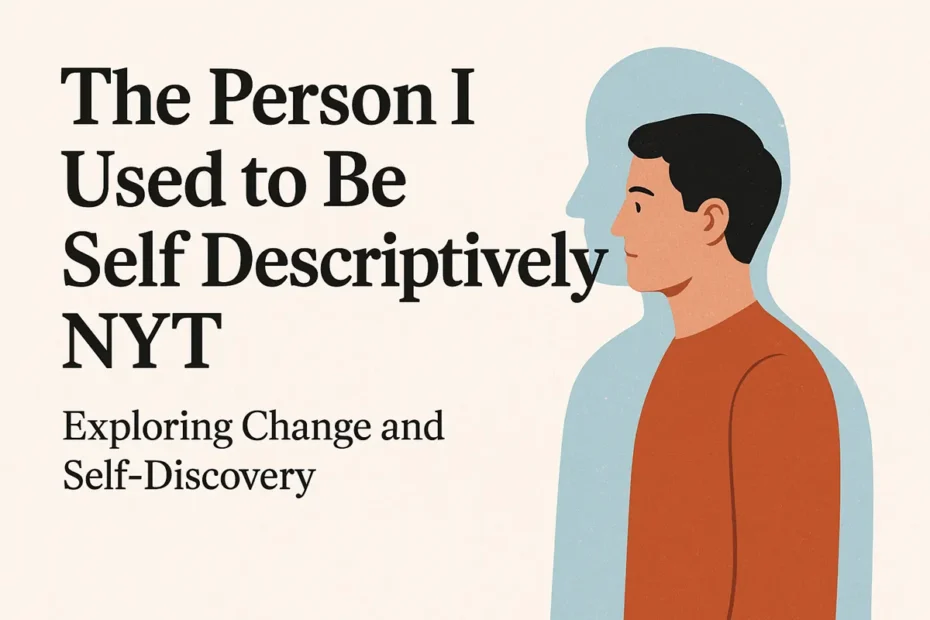Change is one of the most inevitable parts of human existence. We evolve, learn, adapt, and sometimes lose pieces of who we once were. The phrase “the person I used to be self descriptively NYT” captures this very essence, a reflection on how we perceive ourselves through the lens of time and experience. It’s not just about who we were, but how we describe that version of ourselves with honesty and awareness.
Understanding the Phrase
The term “the person I used to be self descriptively NYT” has gained attention from crossword enthusiasts and readers of The New York Times (NYT). In crossword puzzles, such phrases often hint at introspection, personality, or transformation. However, beyond its crossword context, it resonates deeply with anyone who’s ever looked back at their life and realized how much they’ve changed. It encourages us to think about self-description, how we defined ourselves in the past versus how we define ourselves today.
A Journey Through Identity
Every person goes through phases of identity. At different stages, we play unique roles: student, friend, partner, dreamer, or professional. Over time, we shed old identities and grow into new ones. When we think of “the person I used to be self descriptively NYT,” it invites us to remember that transformation is not a loss but a rebirth.
For instance, the carefree teenager may become a responsible adult, the shy individual may grow into a confident speaker, or the skeptic may evolve into a believer. Each phase represents a version of ourselves that once defined our reality. Recognizing “the person I used to be” is a way to respect our growth without feeling bad or guilty.
Self-Reflection and Growth
Self-reflection is a cornerstone of personal growth. By looking back at “the person I used to be self descriptively NYT,” we recognize patterns, mistakes, and lessons that shaped us. This process allows us to appreciate how far we’ve come while also highlighting areas we can still improve.
According to psychologists, self-reflection enhances emotional intelligence and resilience. It helps us make sense of our past actions and decisions, empowering us to move forward with clarity. Describing our former selves honestly without idealization or denial builds a stronger sense of authenticity.
The Role of Language and Description
Language shapes perception. The phrase “self descriptively” emphasizes how we choose words to define ourselves. Whether we describe our old selves as “naive,” “hopeful,” “lost,” or “ambitious,” each word carries emotional weight. It reflects not only who we were but also how we currently interpret that version of ourselves.
Writers at the NYT often explore such introspective themes, connecting language, psychology, and personal evolution. When applied to “the person I used to be self descriptively NYT,” this linguistic reflection becomes a mirror for readers to examine their own journeys.
Why Self-Description Matters
Describing oneself accurately is a powerful act of self-awareness. It connects the past with the present. When we say, “the person I used to be was driven by fear, but now I’m guided by purpose,” we reclaim control over our narrative. This transition from old to new identity is what makes personal growth so meaningful.
By using “the person I used to be self descriptively NYT” as a prompt, individuals can engage in journaling or mindfulness exercises. Writing about your past self can bring closure, forgiveness, and motivation to embrace the person you are becoming.
Lessons Hidden in Crossword Culture
The New York Times crossword is known for its clever play on words and deep cultural references. Phrases like “the person I used to be self descriptively NYT” remind solvers that puzzles often mirror life complex, layered, and filled with meaning beneath the surface. Just as deciphering a crossword clue requires patience, attention, and insight, understanding our own past does too.
Each clue we solve in life brings us closer to the full picture of who we are. And just as in the NYT crossword, the process itself, not just the answer, teaches us the most.
Conclusion
In essence, “the person I used to be self descriptively NYT” is more than a crossword clue; it’s a metaphor for self-reflection and transformation. It challenges us to revisit our past selves with honesty and compassion, recognizing how language and introspection help us grow. Each chapter of our lives holds lessons that shape the narrative of who we are today.
So, take a moment to think about the person you used to be. Describe them truthfully. Then, celebrate how far you’ve come because self-awareness is the key to living with purpose and authenticity.
FAQs:
1. What does “the person I used to be self descriptively NYT” mean?
It refers to a reflective phrase, often seen in The New York Times crossword, describing how someone defines or views their past self through self-awareness.
2. Is “the person I used to be self descriptively NYT” related to a crossword clue?
Yes. It’s a popular crossword clue from The New York Times that combines language play and introspection, often hinting at self-description or change.
3. Why is the phrase “the person I used to be” meaningful in the NYT context?
It highlights the idea of personal growth and transformation, encouraging people to reflect on who they once were compared to who they are now.
4. How can I use “the person I used to be self descriptively NYT” for self-reflection?
You can use it as a writing or journaling prompt to describe your former self honestly, recognize your growth, and appreciate your personal journey.
5. What is the deeper meaning of “the person I used to be self descriptively NYT”?
It’s about acknowledging your evolution, understanding that each version of yourself, past and present, contributes to your overall identity.
